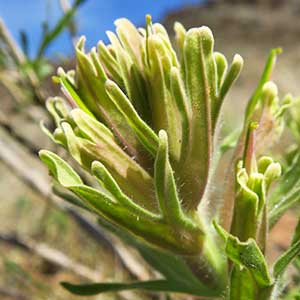Castilleja xanthotricha
Castilleja rubicundula
John Day or yellow-hairy paintbrush, John Day paintbrush, yellow hair paintbrush, yellow-hair Indian paintbrush
cream sacs
few to several, ± decumbent to erect or ascending, unbranched, sometimes with short, leafy axillary shoots, hairs erect to spreading, long, soft, eglandular, mixed with short stipitate-glandular ones.
solitary, erect, unbranched, sometimes branched, hairs spreading, short, soft, often mixed with stipitate-glandular ones.
green, linear, lanceolate to broadly lanceolate, oblong, or cuneate, 0.8–5 cm, not fleshy, margins plane to wavy, involute, 0–5-lobed, apex acute, sometimes rounded;
lobes spreading, linear, arising below mid length, nearly as broad as center lobe, apex acute.
green to purple-tinged or dark red-brown, linear-lanceolate or distal lanceolate, 2–8(–9) cm, not fleshy, margins plane, flat to slightly curved up, 0–7-lobed, apex acute to acuminate;
lobes widely spreading or ascending-spreading, linear, apex acute.
3–14 × 1.5–4.5 cm;
bracts proximally greenish, rarely dull reddish purple, distally white to cream, rarely pale yellow or dull, pale pink (sharply differentiated from proximal coloration), lanceolate or oblong to narrowly ovate, (3–)5–7-lobed;
lobes ascending, linear to obovate, ± broadened distally, medium, long, proximal lobes arising below mid length, central lobe apex broadly rounded to truncate, others acute to rounded.
2.5–24 × 3–4 cm;
bracts green throughout, lanceolate to ovate, 5–9-lobed;
lobes ascending, linear-lanceolate or lanceolate, medium length, arising near mid length, apex acute to acuminate.
curved, 17–23 mm;
tube 15–19 mm;
beak exserted, adaxially green, 5–8(–9) mm, puberulent, stipitate-glandular;
abaxial lip deep purple (color sometimes visible through calyx), green, pinkish, or pale yellow, ± prominent, slightly inflated, usually hidden in calyx, sometimes right at top of calyx, 2 mm, ca. 50% as long as beak;
teeth ascending, whitish, yellowish, pink, or green, 1–1.5 mm.
straight, (15–)20–28 mm;
tube 8–24 mm;
abaxial lip, beak, and proximal part of corolla tube exserted;
beak adaxially white, rarely very pale yellow or pale pink-purple, 5–7 mm, inconspicuously puberulent;
abaxial lip white, fading to pink to pink-purple, or yellow, fading to white, rarely then to pink or pink-purple, both forms often with purple or red dots at base, inflated, prominent, pouches 3, 8–10 mm wide, 4–6 mm deep, 4–6 mm, 80–100% as long as beak;
teeth erect, white or yellow, 0.5 mm.
colored as bracts, 15–26 mm;
abaxial and adaxial clefts 3.5–7 mm, 25–50% of calyx length, deeper than laterals, lateral 2–5 mm, 12–25% of calyx length;
lobes linear, oblong, or narrowly triangular, center lobe apex usually rounded, lobes acute to rounded.
green, 8–14 mm;
abaxial and adaxial clefts 3–6 mm, 30–50% of calyx length, all 4 clefts subequal;
lobes linear, apex acuminate to acute.
± exserted, as long as or slightly longer than beak and visible from abaxial side.
= 48.
= 24.
Castilleja xanthotricha
Castilleja rubicundula
Castilleja xanthotricha is endemic to moderate elevations in the sagebrush hills of the John Day River drainage in north-central Oregon. N. H. Holmgren (1971) hypothesized that this tetraploid species is of allopolyploid hybrid origin between C. glandulifera and C. oresbia.
(Discussion copyrighted by Flora of North America; reprinted with permission.)
Varieties 2 (2 in the flora).
Castilleja rubicundula is separated into two varieties on the basis of flower color, as well as subtle differences in the pouching of the abaxial corolla lip. The ranges of the two varieties are broadly overlapping, but they never grow in the same location. Few intermediate forms have been recorded, though a very unusual population system exists in Santa Clara County, within which virtually all plants exhibit a tricolored corolla sequence, with yellow flowers aging to white and then pink or pink-purple, with all three colors visible on mature inflorescences.
(Discussion copyrighted by Flora of North America; reprinted with permission.)
1. Abaxial lips of corollas white, in most populations quickly fading to pink or pink-purple. | var. rubicundula |
1. Abaxial lips of corollas light to bright yellow, in some populations quickly fading to white, then rarely to pink or pink-purple. | var. lithospermoides |


